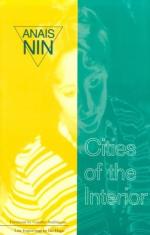|
This section contains 318 words (approx. 2 pages at 300 words per page) |

|
Critics are still debating the various titles which have been applied to Cities of the Interior. Surrealist is the title most often used to describe its lyrical, poetic imagery. Others claim, however, that the work is not Surrealist but Symbolist or modernist. Regardless of title, Cities of the Interior, like the short stories that preceded it, clearly comes from a tradition of introspective, autobiographical literature. Most noticeable is D. H. Lawrence's charged rejection of the intelligence as the only measure of understanding. Nin's early study of Lawrence is interesting for the light it casts on her own work. In D. H. Lawrence: An Unprofessional Study (1932), Nin notes that "Lawrence approaches his characters not in a state of intellectual lucidity but in one of intuitional reasoning . . . His analysis is not one of the mind alone, but of the senses."
Certainly this is one of Nin's objectives and...
|
This section contains 318 words (approx. 2 pages at 300 words per page) |

|




